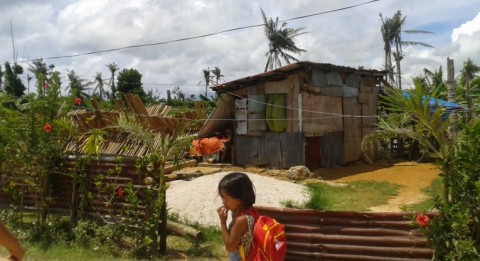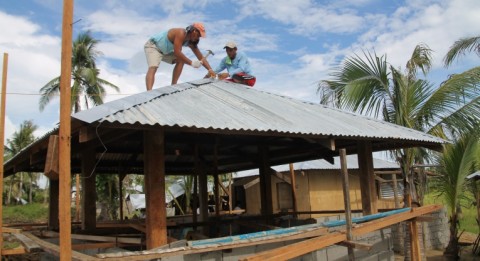2,6 million Haiyan survivors still without new homes
Over seven months after Typhoon Haiyan swept across the Philippines, more than 2.6 million people remain at risk and without durable shelter in the Philippines, according to UN OCHA (Office for the Coordination of Humanitarian Affairs). Reconstruction has not even started in many affected areas, and the next typhoon season is approaching.
With the support from humanitarian organizations or the government, many people have been able to repair or rebuild their homes to a stage where they will be protected from rain. But these structures will not be able to withstand a major storm.

People in the disaster area have been able to repair or rebuild their home strong enough against rainfall.

Servando Alliabas (left) and Joel Abeleno are constructing in Samar-island a four-cornered roof, which has proven resistant to strong winds.
Most evacuation centres have not been repaired after Haiyan. This means that people have no safe places to stay during a typhoon. Also, more than 27,000 people still live in transitional sites, tent cities and evacuation centres.
There is a high risk this situation may lead to another crisis.
A month after Haiyan, the Philippine government launched a “Built Back Better” campaing, committing hundreds of millions of euros to reconstruction. The results are yet to be seen.
“In any disaster people have the right to demand immediate attention from the government. They have the right to relocation and housing. The perception of the resilience of the Philipino people has become a convenient excuse for government neglect”, says Rev’d Rex RB Reyes, Jr., General Secretary of the National Council of Churches in the Philippines.
In the end of May, an overnight fire in a canvas tent killed a mother and all of her six children in one of the tent settlements still remaining in Tacloban city.
20 typhoons a year
During the last five years, weather patterns and even typhoon pathways have changed in the Philippines. The rainy and typhoon season starts in June or July. The strongest south-west monsoon rains are expected to arrive in August. The rains will make any construction work very challenging.
The country has usually 20 typhoons every year, with five of them destructive. The destructive typhoons usually occur during November and December.
Also the El Niño phenomenon can have an effect on the plight of the people in the affected areas. According to The Philippine Atmospheric, Geophysical and Astronomical Services Administration (PAGASA), a majority of climate models indicate that El Niño may develop this year. El Niño generally reduces rainfall, but it also causes tropical cyclones to become erratic and stronger.
Looking forward to a safe home
ACT Alliance member the National Council of Churches in the Philippines (NCCP) has succeeded in securing safe relocation sites for typhoon Haiyan victims.
Evelinda Somo-Oc, 35, is one of Haiyan survivors. She lives in in Barangay Ferreras in Samar, which in May celebrated the Ground Breaking, a ceremony marking the start of building on a new, safe relocation site.
Somo-Oc lost her youngest child, a two-year old son, to Haiyan. Ferreras was badly damaged by typhoon Haiyan, and most of its 548 inhabitants still live in makeshift shelters.
Evelinda Somo-Oc and her family now live right on the sea shore in a small shelter constructed with coco lumber, debris and tarpaulin. Nearby, her four and five-year old daughters, along with a group of children are playing in the shallow water. They are catching small fish, their playthings in the absence of toys.
Soon the family Somo-Oc will get a proper house. NCCP will help all the families now residing within the 40-meter no-build zone to relocate and build progressive core, typhoon-resistant houses. The houses have cement floors. The lower parts of walls are constructed with cement and the upper parts with plywood and lumber. Houses are designed to have four-cornered roofing which has proven resistant to strong winds. Roofs are made of corrugated galvanized iron sheets.
NCCP has succeeded in building a good cooperation with the local government unit. The relocation site on a hill right above Ferreras has been bought by the local government from a private owner.
Evelinda Somo-oc is very happy to relocate to a safe place.
“I am excited already about the new house. And I will love to plant my new garden!”
Evelinda is clearly a born gardener, because even her temporary garden next to the shelter has a great growth.
She is also a fighter, all smiles and laughs, saying that she has to survive because of her daughters.
Text and photos: Ulla Kärki